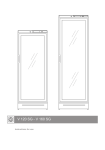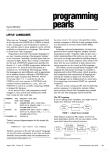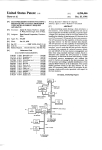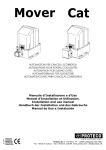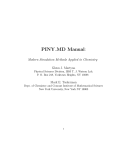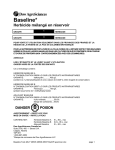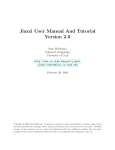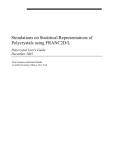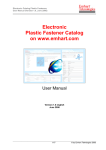Download Vestfrost AKG 317 Technical data
Transcript
AKG 317 - AKG 377 Instructions for use GB Warning. In case this appliance contains hydrocarbon refrigerant please refer to guidelines listed below. a responsible person to ensure that they can use the appliance safely. Young children should be supervised to ensure that they do not play with the appliance As the appliance contains a flammable refrigerant, it is essential to ensure that the refrigerant pipes are not damaged. ●● Always keep the keys in a separate place and out of reach of children Standard EN378 specifies that the room in which you install your appliance must have a volume of 1m³ per 8 g of hydrocarbon refrigerant used in the appliances. This is to avoid the formation of flammable gas/ air mixtures in the room where the appliance is located in the event of a leak in the refrigerant circuit. The quantity of the refrigerant used in your appliance is indicated on the rating plate. ●● Before servicing or cleaning the appliance, unplug the appliance from the mains or disconnect the electrical power supply ●● If the supply cord is damaged, it must be replaced by the manufacturer, its service agent, or similarly qualified persons in order to avoid a hazard ●● Relevant for Australia: Supply cord fitted with a plug complies with AS/NZS 3112. WARNING:Keep ventilation openings in the appliance’s cabinet or in the built-in structure clear of obstruction ●● Frost formation on the interior evaporator wall and upper parts is a natural phenomenon. Therefore, the appliance should be defrosted during normal cleaning or maintenance WARNING:Do not use other mechanical devices or other means to accelerate the defrosting process than those recommended by the manufacturer ●● Directions for replacing the illuminating lamps are to be included in the instruction WARNING:Do not damage the refrigerant system ●● Please note that changes to the appliance construction will cancel all warranty and product liability WARNING:Do not use electrical appliances inside the refrigerated storage compartment, unless they are of a type recommended by the manufacturer WARNING:Do not expose the appliance to rain WARNING:This appliance is not intended for use by young children or infirm persons unless they have been adequately supervised by 2 GB Get to know your pharmaceutical refrigerator: Lock Top lighting Control panel Fan Nameplate Shelf Sealing strip Door handle Glass door Kick plate Temperature control Adjustable feet fig. 2 3 GB Contents Before starting the appliance Warning...................................................2 Before operating your new appliance, please read the following instructions carefully as they contain important information on safety, installation, operation and maintenance. Keep the instructions for future reference. Get to know.............................................3 Before starting the appliance................... 4 Installation and start-up........................... 5 Operation and function............................ 7 On receipt, check to ensure that the appliance has not been damaged during transport. Transport damage should be reported to the local distributor before the appliance is taken into use. Technical data......................................... 8 Reversing the door.................................. 9 Lighting fixture....................................... 11 Remove the packaging. Clean the inside of the cabinet using warm water with a mild detergent. Rinse with clean water and dry thoroughly (see cleaning instructions). Use a soft cloth. Defrosting, cleaning and maintenance...12 Fault finding...........................................13 Warranty, spare parts............................ 14 Disposal.................................................15 If during transport the appliance has been laid down, or if it has been stored in cold surroundings (colder than +5°C), it must be allowed to stabilise in an upright position for at least an hour before being switched on. Note: If the appliance is to be laid down, the door must face upwards and the appliance must be enclosed in the original packaging. 4 GB 25 1530 / 1850 Min. 2000 150 Installation and start-up. Table height width AKG 317 1530 600 depth 595 AKG 377 1850 600 595 The appliance can be installed as a freestanding unit against a wall or side-by-side with other appliances The surface on which the appliance is to be placed must be level. Do not use a frame or similar. If the appliance is to be placed beside a wall, there must be at least 1180 mm clearance on the hinge side to allow the shelves to be removed. To ensure that the door can be opened, the appliance must be pushed no further in than max. 548 mm. max. 548 1180 Side by side In side-by-side arrangements, there must be a clearance of at least 25 mm between the appliances to allow their doors to be opened freely. 600 5 GB Placement Ventilation For safety and operational reasons, the appliance must not be installed outdoors. It is important that the appliance be well ventilated and that air can circulate unhindered above, below and behind it. The appliance should be placed on a level surface in a dry, well ventilated room (max. 70% relative air humidity). Never place the appliance close to sources of heat and avoid placing it in direct sunlight. Note that there must be a clearance of 150 mm above the appliance (see page 5) Levelling the appliance It is important that the appliance be absolutely level. Applications The appliance has been specially designed to maintain a temperature of between 2°C and 8°C inside the cabinet. To ensure that the products are kept within this emperature range, set the thermostat to 4 initially. Whether the thermostat should subsequently be adjusted can then be determined by measuring the temperature inside the cabinet using a thermometer in a glass of water. It can be levelled in the following way: 1. Level the appliance sideways by screwing the adjustable feet up or down using the accompanying spanner. The ambient temperature must be kept between 20°C and 25°C. Important: Note that the door opening frequency will influence the temperature inside the cabinet. Avoid keeping the door open for long periods unnecessarily. 2. Check that the appliance is absolutely level. The appliance is not designed to be used for cooling warm products. Placing such items in the cabinet may cause the temperature of products already in the cabinet to rise. Medicine to be kept between 2°C and 8°C should not be placed in the cabinet higher than the stacking mark or on the bottom shelf. If the appliance is to be placed on a soft surface, e.g. floorboards or a carpet, it is best to recheck whether the appliance is still level after a period of time as the underlying surface may give under the weight of the appliance. Frost protection If the fan inside the cabinet fails, the thermostat will ensure that the temperature of the products stored in the bottom half of the cabinet does not fall below 0°C. The temperature in the top half of the cabinet will, however, rise to ambient temperature. 6 GB Operation and function. 5 4 3 2 Technical data. This device complies with relevant EU directives including Low Voltage Directive 2006/95 EEC. and Electromagnetic Compatibility Directive 2004/108/EC 1 The rating plate provides various technical information as well as type and serial number. Fig fig. 37 Starting up Connect the appliance to the socket outlet. Press the on/off switch . A green light indi2 catet that the appliance has been switched 3 on. 1 Max. 36 kg See control panel Fig 3 1 Green light indicating power on 2 Light switch 3 On/off switch fig. 8 4 Door switch for internal fan 5 Lock The switch (2) on the top right of the control panel is for turning the top lighting on and off. The switch (3) on the top left of the control panel is for turning the appliance on and off. The door switch (4) stops the internal fan when the door is open in order to minimise the amount of warm air entering the cabinet. 7 GB Temperature control 3 1 4 2 5 1: Actual temperature at the top of the cabinet 2: Selection of temperature. Press for 2 seconds 3+4: Temperature +/- 5: Unit on/off Press first button “SET” (2) for about two seconds (until the ° C begins to flash). You can then adjust the temperature using buttons (3) and (4). The calibration can be adjusted between the set points No. 1 and No. 3, the set point No. 1 being the coldest temperature. The temperature at the bottom of the cabinet appears on the display. If you want the temperature at the top of the cabinet to be shown, press button No. 1 for a short while. The temperature is then shown for about 5 seconds, then the display returns to showing the temperature at the bottom of the cabinet. Low temperature alarm: If the temperature is below 1 ° C for more than 4 minutes, an alarm appears on the screen. The audible alarm is reset when the temperature is restored above +1 ° C or when a button is pressed. The visual alarm alternates between LA (= low) and the current temperature of the cabinet. This alarm is switched off when the temperature is back above 1 ° C. High temperature alarm: If the temperature rises above 9 ° C for more than 10 minutes, an alarm appears on the screen. The audible alarm is reset when the temperature is restored above +9 ° C or when a button is pressed. The visual alarm alternates between HA (= high) and the current temperature of the cabinet. This alarm is switched off when the temperature is back above 9 ° C. 8 GB Reversing the door. (Not all appliances have lock.) 1. Remove the lock pin using a flat-headed screwdriver. 2. Remove the lock housing. 3. Loosen the top panel. Do not remove the screws, just loosen them. 4. Tilt the top panel forwards to remove it (it is secured in tree places) 5. Lay the appliance on its back and remove the upper hinge, using the hex key. 6. Pull the torsion spring out of the door together with the hinge. 7. Remove the bottom hinge using the hex key. 8. Move the door handle to the opposite side. 9. Move the hinge pin to the opposite side of the bottom hinge. 10. Refit the bottom hinge on the opposite side. 11. Move the palstic door guard to the opposite side. 12. Insert the hinge pin and tosion spring into the the top of the door on the opposite side. 9 GB 13. Fit the left-side top hinge (available as extra). Tighten the tosion spring approx. 1/2 turn (anticlockwise on left side, clockwise on rigth.) 16. Retighten the top panel screws using a screwdriver. 14. Secure the top hinge in position. 15. Raise the appliance into uppight possion. Click the top panel into place (it is secured in three places.) 17. Refit the lock housing and lock pin. 18. After reversing the door, it is important to check that the sealing strip provides a tight seal all the way round. If it does not, carefully heat the strip all the way round using a hair dryer. Then ease the strip outwards slightly so that it forms a tight seal against the cabinet. Be careful not to heat the strip so much that it melts! 10 GB Lighting fixture. The fluorescent tube can be replaced as follows: 1. Push the cover to the left. 2. Pull the right-hand end of the cover downwards and remove it. Replace the fluorescent tube. Refit the cover in reverse order. Replacing the starter The starter can be replaced as follows: As the starter is located in the right-hand end of the light fitting, it is first necessary to remove the cover as described above. The starter can then be removed/replaced by turning it. Replacing strips Strips can be replaced as follows: Strips (possibly containing text) can be removed from the cover by pulling it out of the guides along its entire length. 11 GB Defrosting, cleaning and maintenance. Automatic defrosting. It is possible to clean beneath the appliance by removing the kick plate The wine cooler is defrosted automatically. Defrost water runs through a pipe and is collected in a tray above the compressor where the heat generated by the compressor causes it to evaporate. The defrost water tray should be cleaned at intervals. 1. Loosen the kick plate using the accompanying hex key. 2. Carefully tilt the kick plate forwards. Be careful not to damage cables during cleaning. Cleaning. Before cleaning the appliance, unplug it from the main supply. The cabinet is best cleaned using warm water (max. 65°C) with a little mild detergent. Never use cleaning agents that scour. Use a soft cloth. Rinse with clean water and dry thoroughly. The defrost water channel, in which condensation from the evaporator runs, is located at the bottom of the rear inside wall of the cabinet and must be kept clean. Add a few drops of disinfectant to the defrost water drain a couple of times a year, and clean the drain using a pipe cleaner or similar. Never use sharp or pointed implements. fig. 9 The sealing strip around the door must be cleaned regularly to prevent discolouration and prolong service life. Use clean water. After cleaning the sealing strip, check that it continues to provide a tight seal. fig. 10 Dust collecting on the condenser on the rear of the cabinet, the compressor and in the compressor compartment is best removed using a vacuum cleaner. 12 GB Fault finding. Fault Possible cause Remedy No control lamps are lit. The appliance is switched off. Press the on/off switch Power failure; the fuse is blown; the appliance is not plugged on correctly Vibration or brothersome noise The appliance is not level The appliance is resting against other elements. Check that power has been connected, both on the wall socket and control panel. Reset the fuse. Level the appliance using a spirit level. Move the appliance away from oyher elemenets or appliance it is in contact with Compressor runs continuously High room temperature. Ensure adequante ventilation around the appliance. The temperature is too high at the top of the cabinet The internal fan is not working. Close the door. If the fan fails to start, call for service Excessive ice forms on evaporator * The internal fan is not working. Close the door. If the fan fails to start, call for service Display showing P1/P2 Sensor error If P1 - remove products in the appliance - call for service. If P2 - only display does not work - call for service. * It is quite natural for a thin layer of ice to form on the evaporator when the compressor is running. Such ice disappears when the compressor stops running. 13 GB Warranty, spare parts and service. Warranty disclaimer Spare parts Faults and damage caused directly or indirectly by incorrect operation, misuse, insufficient maintenance, incorrect building, installation or mains connection. Fire, accident, lightening, voltage variation or other electrical interference, including defective fuses or faults in mains installations. When ordering spare parts, please state the type, serial and product numbers of your appliance. This information is given on the rating plate. The rating plate contains various technical information, including type and serial numbers. Repairs performed by others than approved service centres and any other faults and damage that the manufacturer can substantiate are caused by reasons other than manufacturing or material faults are not covered by the warranty. Please note that changes to the construction of the appliance or changes to the component equipment of the appliance will invalidate warranty and product liability, and the appliance cannot be used lawfully. The approval stated on rating plate will also be invalidated. Product number. Transport damage discovered by the buyer is primarily a matter to be settled between the buyer and the distributor, i.e. the distributor must ensure that such complaints are resolved to the buyer’s satisfaction. Before calling for technical assistance, please check whether you are able to rectify the fault yourself. If your request for assistance is unwarranted, e.g. if the appliance has failed as a result of a blown fuse or incorrect operation, you will be charged the costs incurred by your call for technical assistance. 14 GB Disposal For business users in the European Union. If you wish to discard electrical and electronic equipment, please contact your dealer or supplier for further information. Information for Users on Collection and Disposal of Old Equipment and used Batteries These symbols on the products, packaging, and/or accompanying documents mean that used electrical and electronic products and batteries should not be mixed with general household waste. For proper treatment, recovery and recycling of old products and used batteries, please take them to applicable collection points, in accordance with your national legislation and the Directives 2002/96/EC and 2006/66/EC. [Information on Disposal in other Countries outside the European Union] These symbols are only valid in the European Union. If you wish to discard this product, please contact your local authorities or dealer and ask for the correct method of disposal. Note for the battery symbol (bottom two symbol examples): By disposing of these products and batteries correctly, you will help to save valuable resources and prevent any potential negative effects on human health and the environment which could otherwise arise from inappropriate waste handling. This symbol might be used in combination with a chemical symbol. In this case it complies with the requirement set by the Directive for the chemical involved. For more information about collection and recycling of old products and batteries, please contact your local municipality, your waste disposal service or the point of sale where you purchased the items. Penalties may be applicable for incorrect disposal of this waste, in accordance with national legislation. 15 Reserving the right to alter specifications without prior notice. 0-91.93.159-02
















